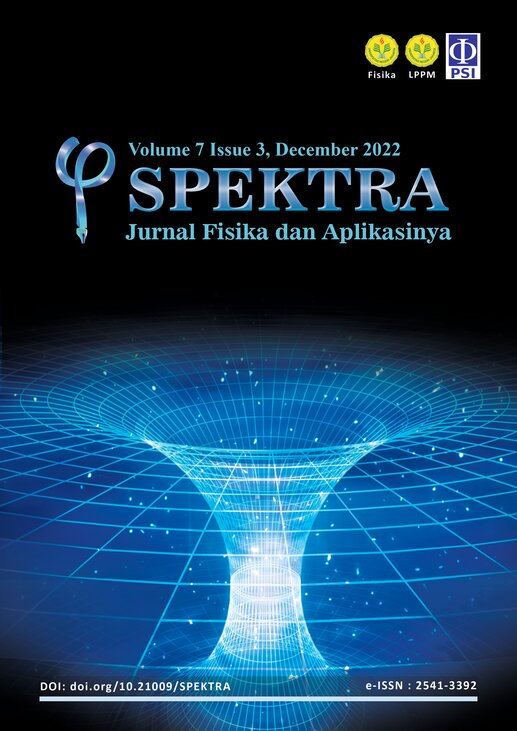THE DENSITY FUNCTIONAL THEORY STUDY OF Li-ION DIFFUSION IN Na-DOPED Li4Ti5O12 AS LITHIUM-ION BATTERY ANODE
DOI:
https://doi.org/10.21009/SPEKTRA.073.04Keywords:
lithium-ion battery, lithium titanate, Li-ion diffusion, DFTAbstract
Spinel phase lithium titanate (Li4Ti5O12 or LTO) has been studied as an alternative anode material with a “zero-strain” characteristic structure to improve safety, cycling stability, and rate performance. LTO offers stable Li-ion diffusion at a higher charge-discharge rate without noticeable structural change. However, LTO exhibits low electronic conductivity and low Li-ion diffusion compared to graphite-based anode materials, limiting its rate capability. In this study, we investigate the impact of Na atom doping on the diffusion rate in the Li4Ti5O12 (LTO) spinel phase using the density functional theory (DFT). Based on the nudged elastic band (NEB) calculation, we obtain the energy barrier values and each diffusion pathway, with barrier energy varying about 0.3~0.4 eV and affecting the value of the diffusion constant obtained. The study reveals the role of Na atom doping in the lithium-ion diffusion in NaxLi4-xTi5O12 for battery anode material.
References
[2] A. Tomaszewska et al., “Lithium-ion battery fast charging: A review,” Publisher Full Text, e-Transportation, vol. 1, 2019, doi: 10.1016/j.etran.2019.100011.
[3] B. Ziebarth, et al., “Lithium diffusion in the spinel phase Li4Ti5O12 and in the rocksalt phase Li7Ti5O12 of lithium titanate from first principles,” Phys. Rev. B - Condens. Matter Mater. Phys., vol. 89, no. 17, 2014, doi: 10.1103/PhysRevB.89.174301.
[4] K. Tada, et al., “A comparative study of Na3LiTi5O12 and Li4Ti5O12: Geometric and electronic structures obtained by density functional theory calculations,” Chemical Physics Letters, vol. 731, 2019, doi: 10.1016/j.cplett.2019.136598.
[5] A. Van der Ven and G. Ceder, “Lithium diffusion mechanisms in layered intercalation compounds,” in Journal of Power Sources, vol. 97-98, 2001, doi: 10.1016/S0378-7753(01)00638-3.
[6] M. Wilkening et al., “Microscopic Li self-diffusion parameters in the lithiated anode material Li4+xTi5O12 (0 ≤ x ≤ 3) measured by 7Li solid state NMR,” Phys. Chem. Chem. Phys, vol. 9, no. 47, 2007, doi: 10.1039/b713311a.
[7] L. Zhang et al., “Enhancing the electrochemical performance of Li4Ti5O12 anode materials by codoping with Na and Br,” Journal of Alloys and Compounds, vol. 903, 2022, doi: 10.1016/j.jallcom.2022.163962.
[8] S. Loftager et al., “A Density Functional Theory Study of the Ionic and Electronic Transport Mechanisms in LiFeBO3 Battery Electrodes,” The Journal of Physical Chemistry, vol. 120, no. 33, 2016, doi: 10.1021/acs.jpcc.6b03456.
[9] Berkeley Lab, “The Materials Project is powered by open-source software, mp-685194: Li4Ti5O12 (monoclinic, C2/c, 15),” https://materialsproject.org/materials/mp-685194/.
[10] K. Kataoka et al., “Single crystal growth and structure refinement of Li4Ti5O12,” J. Phys. Chem. Solids, vol. 69, no. 5, pp. 1454-1456, 2007, doi: 10.1016/j.jpcs.2007.10.134.
[11] K. Momma and F. Izumi, “VESTA 3 for three-dimensional visualization of crystal, volumetric and morphology data,” J. Appl. Crystallogr, vol. 44, no. 6, 2011, doi: 10.1107/S0021889811038970.
[12] P. Giannozzi et al., “QUANTUM ESPRESSO: A modular and open-source software project for quantum simulations of materials,” J. Phys. Condens. Matter, vol. 21, no. 39, 2009, doi: 10.1088/0953-8984/21/39/395502.
[13] M. Ernzerhof et al., “Coupling-constant dependence of atomization energies,” Int. J. Quantum Chemistry, vol. 64, no. 3, pp. 285-295, 1997, doi: 10.1002/(SICI)1097-461X(1997)64:3<285::AID-QUA2>3.0.CO;2-S.
[14] H. J. Monkhorst and J. D. Pack, “Special points for Brillouin-zone integrations,” Phys. Rev. B, vol. 13, no. 12, 1976, doi: 10.1103/PhysRevB.13.5188.
[15] G. Henkelman, B. P. Uberuaga and H. Jónsson, “Climbing image nudged elastic band method for finding saddle points and minimum energy paths,” J. Chem. Physics, vol. 113, no. 22, 2000, doi: 10.1063/1.1329672.
[16] Z. N. Ezhyeh et al., “Review on doping strategy in Li4Ti5O12 as an anode material for Lithium-ion batteries,” Ceramics International, 2022, doi: 10.1016/J.CERAMINT.2022.04.340.
Downloads
Published
How to Cite
Issue
Section
License
SPEKTRA: Jurnal Fisika dan Aplikasinya allow the author(s) to hold the copyright without restrictions and allow the author(s) to retain publishing rights without restrictions. SPEKTRA: Jurnal Fisika dan Aplikasinya CC-BY or an equivalent license as the optimal license for the publication, distribution, use, and reuse of scholarly work. In developing strategy and setting priorities, SPEKTRA: Jurnal Fisika dan Aplikasinya recognize that free access is better than priced access, libre access is better than free access, and libre under CC-BY or the equivalent is better than libre under more restrictive open licenses. We should achieve what we can when we can. We should not delay achieving free in order to achieve libre, and we should not stop with free when we can achieve libre.
 SPEKTRA: Jurnal Fisika dan Aplikasinya is licensed under a Creative Commons Attribution 4.0 International License.
SPEKTRA: Jurnal Fisika dan Aplikasinya is licensed under a Creative Commons Attribution 4.0 International License.
You are free to:
Share - copy and redistribute the material in any medium or format
Adapt - remix, transform, and build upon the material for any purpose, even commercially.
The licensor cannot revoke these freedoms as long as you follow the license terms.

 E-ISSN 2541-3392
E-ISSN 2541-3392  Focus & Scope
Focus & Scope  Editorial Team
Editorial Team  Reviewer Team
Reviewer Team  Author Guidelines
Author Guidelines  Article Template
Article Template  Author Fee
Author Fee  Publication Ethics
Publication Ethics  Plagiarism Policy
Plagiarism Policy  Open Access Policy
Open Access Policy  Peer Review Process
Peer Review Process  Retraction & Correction
Retraction & Correction  Licensing & Copyright
Licensing & Copyright  Archiving & Repository
Archiving & Repository  Contact
Contact  Mendeley
Mendeley 

